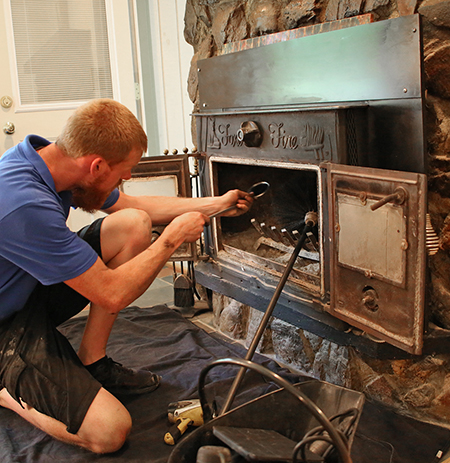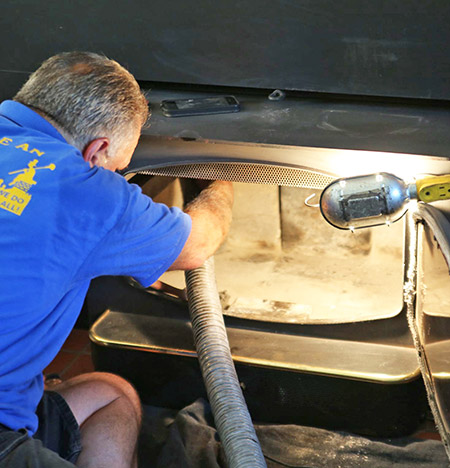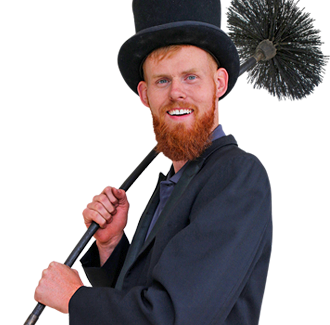5 Tips from a Chimney Sweep on How to Build Ecofriendly Fires & Save Money
 Every time you build a fire in your fireplace or woodstove it can have an impact on the environment. The smoke that wafts out of your chimney contains toxic gases like carbon monoxide, volatile organic compounds, harmful particles, and, potentially, carcinogens like benzopyrene according to the EPA. Burning wood in an old fireplace or woodstove can contribute to air pollution and cause public health problems.
Every time you build a fire in your fireplace or woodstove it can have an impact on the environment. The smoke that wafts out of your chimney contains toxic gases like carbon monoxide, volatile organic compounds, harmful particles, and, potentially, carcinogens like benzopyrene according to the EPA. Burning wood in an old fireplace or woodstove can contribute to air pollution and cause public health problems.
If you’re worried about the environmental impact of burning wood, you don’t have to stop using your fireplace or wood-burning stove. It is possible to heat your home with wood without hurting the environment. Using wood can be an ecofriendly way to heat your home—by decreasing your reliance on fossil fuels and reducing your contribution to greenhouse gas production—as long as you learn how to build clean burning fires.
Here are 5 tips from our chimney sweeps to help you build environmentally friendly fires.
#1 – Use the Right Types of Wood
The types of firewood and kindling that you use make a big difference.
You should always use seasoned wood. Seasoned firewood is any wood that has dried out for at least 6 months. The seasoning process is important because wood has a high moisture content when it has been freshly cut. It takes at least 6 months for wood to dry out enough to burn well. If you make a fire with freshly cut wood or wood that is wet from a recent rainstorm, it will produce more air pollutants when it burns.
We also recommend burning hardwoods (like oak, maple, beech and ash) because they release less emissions and particles when they burn than softwoods (like pine, spruce and fir).
#2 – Be Careful About What You Burn
You might think it is a good idea to use magazine pages or cardboard as kindling instead of sending them to a landfill. Unfortunately, burning them can release toxic chemicals into the air. You should never burn dyed paper, cardboard, plastic, plywood, chipboard, particle board, or any type of lumber that has been painted or treated. All of these can release toxic chemicals that are bad for your health and the environment.
The safest types of kindling to use for your fire are non-dyed paper, newspaper with only black ink, and sticks or chips of wood.
#3 – Use the Correct Grate Size for Your Fireplace or Stove
If your fireplace or stove has an oversized grate you will be more likely to spreading out the logs when you build a fire. This will reduce the efficiency of your fire meaning that the fire won’t be as hot, the wood won’t burn as completely, and it will create more smoke. It is better to have a smaller grate that forces you to stack your logs closer together. This will create a hotter, cleaner fire.
#4 – Upgrade Your Fireplace or Woodstove
There is a reason why old fireplaces and ancient wood-burning stoves produce a lot of smoke. These old heating sources aren’t even half as efficient as fireplace inserts and modern wood-burning stoves. Traditional masonry fireplaces can have as low as a 5% efficiency rating. In contrast, new fireplace inserts and woodstoves usually have efficiency ratings between 70% and 80%.
Upgrading your fireplace with a fireplace insert or swapping out your old stove for a new one will significantly reduce the emissions your fires release. These new heating appliances are EPA-certified, which means that they meet or exceed the Environmental Protection Agency’s clean air standards.
Along with making your fire burn cleaner, they also produce more heat with less fuel. That is why many people who are trying to go green use a fireplace insert or woodstove to heat their home. If you live in New York, you may be eligible to receive a tax benefit or rebate for installing an EPA-certified wood-burning stove as long as it meets the state’s requirements.
#5 – Don’t Try DIY Chimney Cleaning Solutions
 Having your chimney cleaned and inspected at least once a year is important. Using your chimney year after year without cleaning it reduces your fireplace or stove’s efficiency and safety. Whenever you burn wood, creosote (a combustible, chemical compound) builds up along the walls of the chimney. As it builds up, it constricts the flow of oxygen to the fire which decreases the fire’s efficiency. It is also a serious fire hazard.
Having your chimney cleaned and inspected at least once a year is important. Using your chimney year after year without cleaning it reduces your fireplace or stove’s efficiency and safety. Whenever you burn wood, creosote (a combustible, chemical compound) builds up along the walls of the chimney. As it builds up, it constricts the flow of oxygen to the fire which decreases the fire’s efficiency. It is also a serious fire hazard.
It’s smart to have your chimney cleaned either at the end or the beginning of the burning season every year. But tackling this project on your own isn’t a good idea.
Every chimney sweep can tell you stories about the outlandish chimney cleaning remedies we’ve heard like the myths that burning rock salt or potato peels can get rid of creosote. Some DIY solutions like these are harmless but also ineffective. Other DIY solutions are dangerous. Building a large, hot fire to burn out creosote in your chimney is the most dangerous. The small, controlled chimney fire you are expecting to ignite can easily get out of control and become a house fire. Hiring a professional chimney sweep that has been certified by the Chimney Safety Institute of America (CSIA) is the safest and most effective way to have your chimney cleaned. We have the correct equipment, chemicals and training to safely clean your chimney.
We hope this has helped you learn how to build an ecofriendly fire. If you need an estimate for your annual chimney cleaning, give us a call (845)471-1071! We serve residents throughout New York’s Hudson Valley and Western Connecticut.








